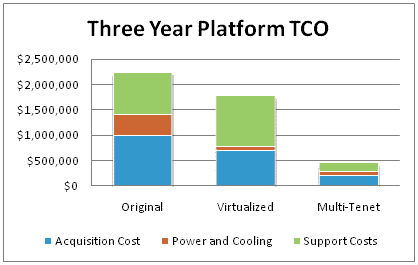Multi-Tenant TCO
Brian
I recently presented an overview of multi-tenancy in one of my MBA classes. I discussed how multi-tenant applications allow cloud vendors to achieve economies of scale. As an example, I showed the effect on total cost of ownership for the infrastructure if a cloud vendor moved from physical to virtual and then to a multi-tenant architecture. The multi-tenant architecture cuts cost by 80%.
Current State
Imagine that you work at a midsize company that develops and hosts a SaaS (Software as a Service) solution. You have been growing recently and now have 100 customers. Each customer gets its own server that your company hosts in its datacenter.
You are currently supporting 100 physical servers. Unfortunately, the average utilization is only about 10%. Over three years, the total cost of ownership is about $2.2M ($1M for hardware acquisition, $400K for power, and $800K for support).
Virtualization
Now imagine that IT moves to virtualization. If we are only 10% utilized, it follows that we only need 10 physical servers (each hosting 10 virtual servers). Leaving some room for growth and sudden spikes in demand, we decide to be safe and buy 20 servers (each hosting 5 virtual servers).
This cuts our acquisition costs by 30%, and our power costs 80%, but notice that our support costs have gone up by 20%. Why? We now have 20 additional servers to support (100 VMs and 20 physical).
Multi-Tenancy
Now image that we rewrote our applications to allow us to host multiple clients on the same server (i.e. multi-tenant). Again we decide to be safe and buy 20 servers. But, note that we longer need the 100 virtual servers. Therefore, our acquisition costs drop dramatically. We just cut $500K in licensing costs. In addition, out support team is only supporting 20 servers saving another $750K.
Conclusion
Multi-tenant applications have dramatic impact on total cost of ownership. This allows cloud vendors to achieve economies of scale. What does this mean for the CIO? In general the best option for the average IT department is virtualization. Therefore, a SaaS solution can often be cheaper than hosting a solution in your own datacenter. This is true even after the vendor applies his markup.
